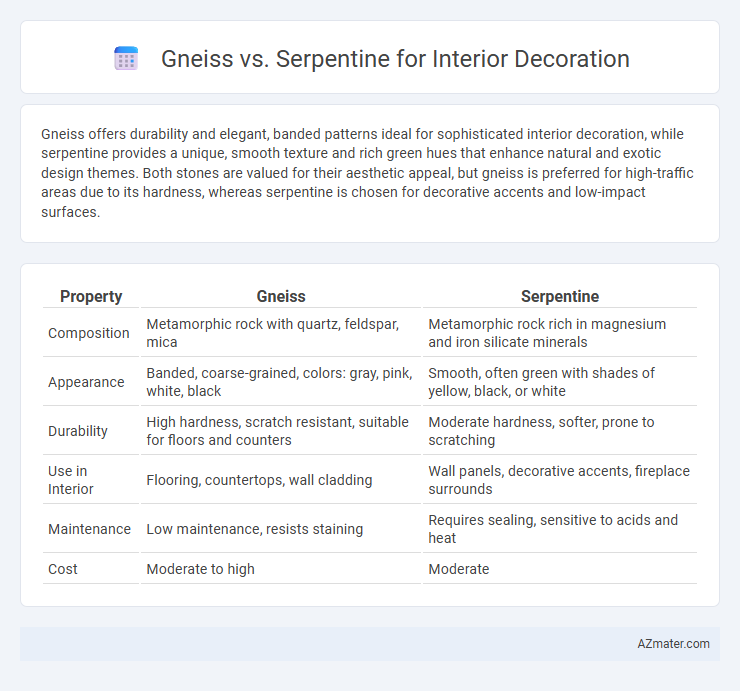Gneiss offers durability and elegant, banded patterns ideal for sophisticated interior decoration, while serpentine provides a unique, smooth texture and rich green hues that enhance natural and exotic design themes. Both stones are valued for their aesthetic appeal, but gneiss is preferred for high-traffic areas due to its hardness, whereas serpentine is chosen for decorative accents and low-impact surfaces.
Table of Comparison
| Property | Gneiss | Serpentine |
|---|---|---|
| Composition | Metamorphic rock with quartz, feldspar, mica | Metamorphic rock rich in magnesium and iron silicate minerals |
| Appearance | Banded, coarse-grained, colors: gray, pink, white, black | Smooth, often green with shades of yellow, black, or white |
| Durability | High hardness, scratch resistant, suitable for floors and counters | Moderate hardness, softer, prone to scratching |
| Use in Interior | Flooring, countertops, wall cladding | Wall panels, decorative accents, fireplace surrounds |
| Maintenance | Low maintenance, resists staining | Requires sealing, sensitive to acids and heat |
| Cost | Moderate to high | Moderate |
Introduction to Gneiss and Serpentine
Gneiss and serpentine are popular natural stones used in interior decoration, each offering unique aesthetic and structural qualities. Gneiss is a metamorphic rock characterized by its pronounced banding and granular texture, with colors ranging from gray to pink, making it ideal for countertops, flooring, and wall cladding. Serpentine, known for its rich green hues and smooth, waxy surface, provides a sophisticated appearance and is often used for accent walls, flooring, and decorative elements in luxury interiors.
Geological Formation and Composition
Gneiss, formed through high-grade regional metamorphism of granite or sedimentary rocks, exhibits a banded texture with alternating light and dark mineral layers primarily composed of quartz, feldspar, and mica. Serpentine originates from the metamorphism of ultramafic rocks, predominantly composed of serpentine group minerals such as chrysotile, lizardite, and antigorite, resulting in a smooth, often greenish surface ideal for decorative use. The distinct geological origins of gneiss and serpentine influence their durability and aesthetic appeal, making gneiss suitable for structurally supportive interiors and serpentine favored for its unique color variations and polish.
Visual Appearance and Color Variations
Gneiss offers a striking visual appeal with its banded texture and range of colors from gray, white, pink, to tan, creating a natural, layered look ideal for sophisticated interior decoration. Serpentine stands out with its unique green shades, often mixed with black or white veins, providing a rich, luxurious aesthetic that is perfect for feature walls and countertops. Both stones bring distinct visual textures, but gneiss emphasizes earthy, linear patterns, while serpentine highlights smooth, flowing color variations that enhance a space's organic vibe.
Durability and Strength Comparison
Gneiss, a high-grade metamorphic rock, offers exceptional durability and strength, making it ideal for high-traffic interior spaces due to its resistance to wear and fracture. Serpentine, while visually appealing with its rich green hues, is softer and less dense, resulting in lower resistance to scratches and impact, which limits its use in areas requiring robust performance. For interior decoration focused on long-term strength and durability, gneiss outperforms serpentine by providing greater structural integrity and longevity.
Maintenance and Cleaning Requirements
Gneiss offers low-maintenance durability due to its hardness and resistance to scratches, requiring only regular sweeping and occasional damp mopping with a pH-neutral cleaner. Serpentine, while visually appealing with its unique green hues, demands more careful maintenance to prevent staining and etching, typically necessitating sealants and gentle cleaning agents. Both stones benefit from prompt spill cleanup, but gneiss is better suited for high-traffic interior areas due to its robustness.
Cost and Availability
Gneiss is typically more affordable and widely available for interior decoration due to its abundance and varied color options, making it a popular choice for flooring and countertops. Serpentine, known for its distinctive green hues and unique veining, tends to be more expensive and less readily available, often sourced from specific quarries, which can increase lead times and costs. Both materials offer durability, but budget-conscious projects usually favor gneiss for its cost-effectiveness and easier procurement.
Applications in Interior Spaces
Gneiss offers durability and a sophisticated, banded texture ideal for flooring, wall cladding, and countertops in modern interior spaces. Serpentine's unique green hues and smooth surface are popular for accent walls, decorative tiles, and fireplace surrounds, adding a natural, elegant touch. Both stones are valued for their aesthetic appeal and functional resilience, with gneiss often preferred for high-traffic areas and serpentine chosen for ornamental features.
Environmental Sustainability
Gneiss, a highly durable and naturally occurring metamorphic rock, offers exceptional longevity and minimal maintenance, reducing the need for frequent replacements and conserving resources. Serpentine, although aesthetically appealing with its unique green hues, often requires intensive mining processes that can lead to higher environmental impacts due to habitat disruption and chemical treatments for stabilization. Choosing gneiss for interior decoration aligns with sustainable building practices by minimizing ecological footprints and promoting resource efficiency in long-term applications.
Design Trends and Aesthetic Appeal
Gneiss and serpentine are popular choices for interior decoration, each offering unique design trends and aesthetic appeal. Gneiss features a distinctive banded texture with earthy tones, complementing modern and rustic interiors through its natural, elegant appearance. Serpentine boasts rich green hues and smooth, variegated patterns, making it ideal for creating luxurious and bold statements in contemporary and eclectic spaces.
Choosing Between Gneiss and Serpentine for Your Interior
Gneiss offers a durable, elegant texture with its foliated grains and mineral variations, making it ideal for countertops, flooring, and accent walls in interior decoration. Serpentine provides a unique, rich green color palette with a smooth, polished surface, suitable for decorative countertops and sculptural elements, but is softer and requires more maintenance. When choosing between gneiss and serpentine, consider durability, aesthetic preference, and maintenance needs to match the specific functional and visual requirements of your interior space.

Infographic: Gneiss vs Serpentine for Interior Decoration
 azmater.com
azmater.com